Growing Walnut trees at home can be a rewarding and fulfilling experience. Moreover, growing Walnut trees at home promotes sustainability. With their round shape and hard shell, Walnuts are stone fruits with a single seed. Taking care of your Walnut tree is crucial to ensure it grows healthy and produces abundant fruits.
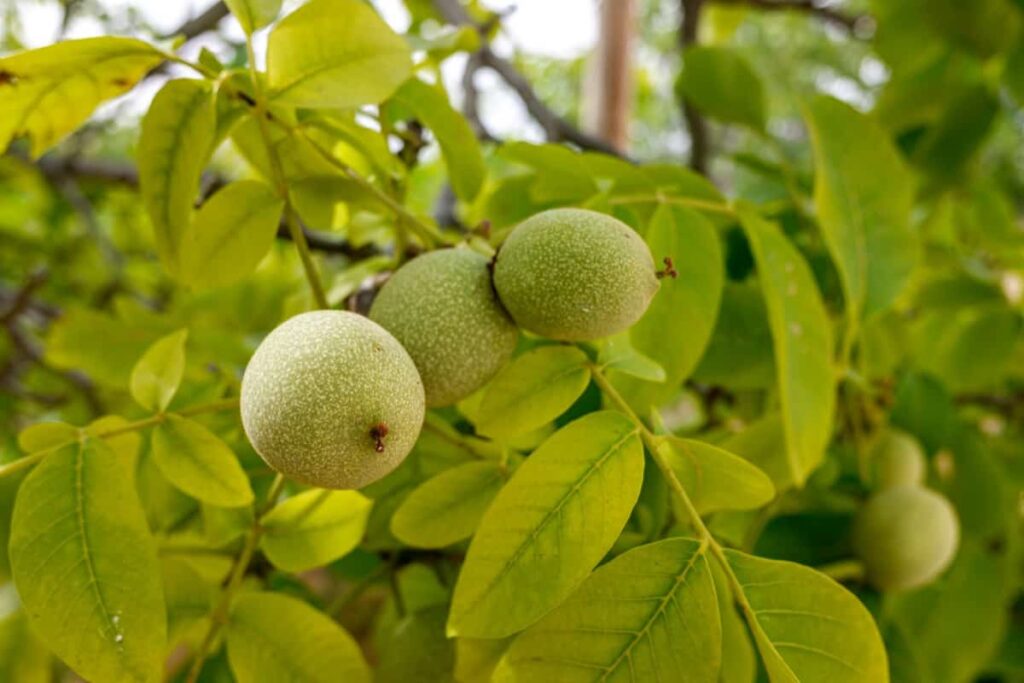
How to Grow Walnut Tree at Home
Walnut Tree Varieties for Your Home
The most common Walnut Tree varieties are the Butternut, English, and Black Walnut. The Butternut tree is native to North America. It produces delicious nuts with a rich flavor often used in baking and cooking. The Butternut tree is smaller than other Walnut trees, making it a great option for smaller yards or gardens. The English Walnut tree is another popular choice among home gardeners. T
This variety produces large nuts with a thin shell that is easy to open. The nuts have a mild and delicate flavor, making them perfect for snacking or adding to salads and desserts. Another variety is the Black Walnut tree. This variety is known for its distinctive dark wood and flavorful nuts. Black Walnuts have a strong, earthy taste that adds depth to dishes like ice cream or baked goods.
Preparing the Soil for Planting Walnut Trees
Preparing the soil is crucial in successfully planting Walnut trees at home. Before you begin, it’s important to assess the quality and composition of your soil. Walnut trees prefer well-draining soil that is rich in organic matter.
In case you missed it: How to Grow Pistachios at Home: Propagation, Planting, Pollination, Care, and Yield
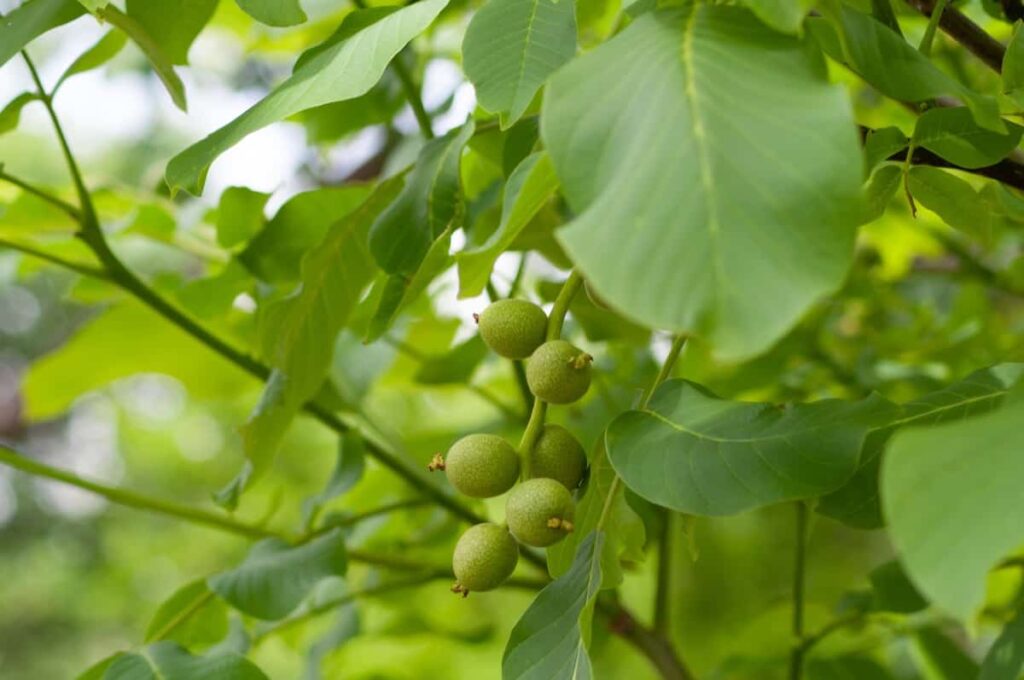
Adding organic matter can greatly enhance the fertility of your soil. Mix a layer of organic matter over the planting area into the top few inches of soil. It’s also important to test your soil’s pH level before planting. Walnut trees prefer slightly acidic to neutral soils with a pH level of 6 and 7. Adjust the pH level by adding lime or sulfur according to recommended guidelines.
Providing Adequate Sunlight and Water for Walnut Trees
Sunlight and water are two crucial elements that contribute to the healthy growth of Walnut trees. These majestic trees thrive in full sun, so choosing a location to receive at least six to eight hours of direct sunlight each day is essential. Young saplings require regular watering during their first few years, especially during dry periods. Aim to provide about 1-2 inches of water per week through rainfall or manual irrigation.
However, it’s important not to overwater Walnut trees as they prefer well-draining soil. Excessive moisture can result in root rot and other fungal diseases. To prevent this, ensure the soil has good drainage and only water when the top few inches feel slightly dry. Additionally, mulching around the base of your Walnut tree can help retain soil moisture while suppressing weed growth.
Propagation Methods for Walnut Trees
You can use several propagation methods to grow Walnut trees at home. One common method is through grafting, where a small piece of the desired Walnut variety (known as the scion) is attached to the rootstock of another tree. This method ensures that your new Walnut tree will have all the characteristics and qualities of the parent tree. Another propagation method is through hardwood cuttings. Take cuttings from healthy branches of an established Walnut tree in late winter or early spring.
Remove any leaves and make sure each cutting has at least three buds. Plant these cuttings in a well-draining soil mix and keep them moist until they develop roots. You can also propagate Walnuts using air layering, which involves creating a wound on a branch and wrapping it with damp moss or plastic wrap to encourage root growth. Once roots have formed, you can remove this section from the parent plant and transplant it into its container or directly into the ground.
In case you missed it: How to Grow Olive Trees in Pots: A Comprehensive Guide for Planting and Care
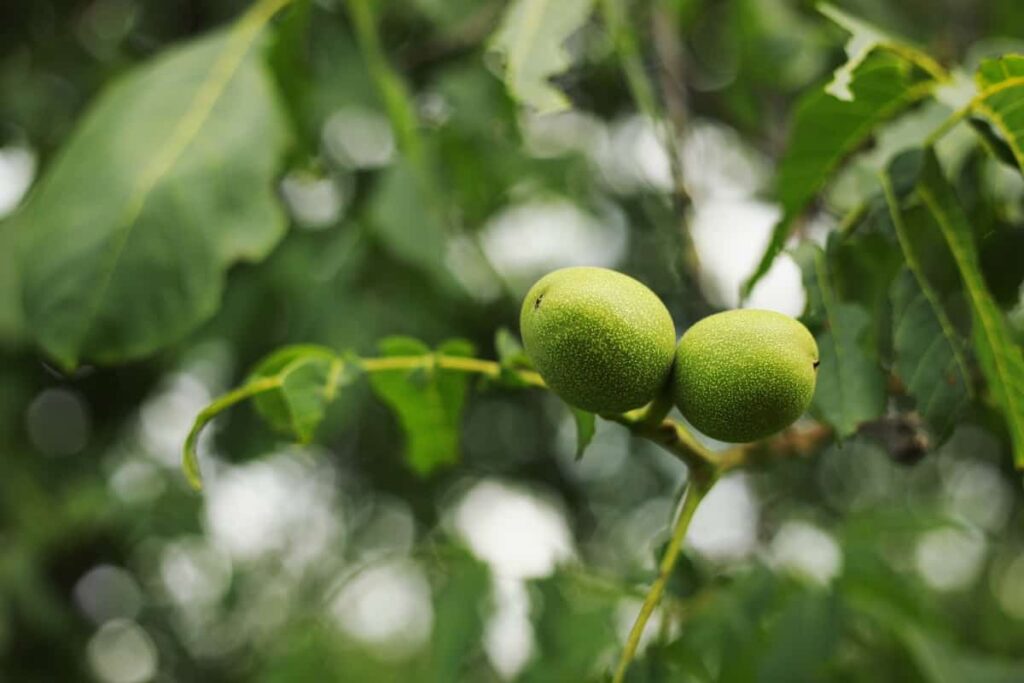
You can try propagating Walnuts by seed sowing. Collect mature nuts in autumn and store them in cool conditions until springtime arrives. Then, plant them about an inch deep in pots filled with sandy loam soil mixture. Keep these pots indoors or in a greenhouse until they germinate.
Planting Walnut Trees: Step-by-Step Guide
Firstly, choose a suitable location with well-drained soil and plenty of sunlight. This will ensure your Walnut tree thrives. Next, prepare the soil by removing weeds or grass from where you plan to plant your Walnut tree. Dig a hole that is deep enough to accommodate the tree roots. Carefully place the tree in the hole, ensuring it sits upright and its root collar is level with or above ground level.
Then, backfill the hole by using soil and gently firming it around the tree’s base. Be careful not to compact the soil too much, hindering root growth. Water your newly planted Walnut tree thoroughly after planting. Apply a layer of mulch around the tree’s base to help retain moisture and suppress weed growth. Monitor your Walnut tree closely during its first year of growth, providing regular watering as needed. Prune any damaged or crossing branches during this time to encourage healthy growth.
Mulching and Fertilizing Walnut Trees for Optimal Growth
Mulching helps to retain moisture, regulate soil temperature, suppress weed growth, and improve soil structure. It also acts as a protective barrier against extreme weather conditions. Use organic materials when mulching your Walnut tree. Fertilizing Walnut trees is crucial for providing them with nutrients for healthy growth and fruit production.
Before applying any fertilizer, it’s important to conduct a soil test to determine its nutrient requirements. Use a balanced fertilizer for nut trees and follow the recommended application rates. Regular monitoring of leaf color and overall tree health will help you adjust your fertilization practices accordingly.
Pruning and Training Walnut Trees for a Strong Structure
Pruning and training your Walnut trees is essential to ensure they develop a strong, healthy structure. When done correctly, it promotes optimal growth and helps prevent diseases and pest infestations. Start by removing dead or diseased branches as soon as you spot them. This will prevent the spread of plant disease and allow the Walnut tree to focus its energy on healthy growth. Additionally, remove branches crossing or rubbing against each other, which can cause damage over time.
Next, pay attention to the central leader of the tree. It’s important to encourage one main trunk that is the backbone of the tree’s structure. Remove competing leaders or side shoots that may hinder its development. As your Walnut tree grows taller, consider thinning out excessive branches in the canopy. This allows better airflow and reduces the risk of fungal infections caused by poor ventilation. Aim for an open canopy with well-spaced branches to maximize sunlight penetration.
In case you missed it: Growing Stages of Onions and Onion Growth Time Lapse
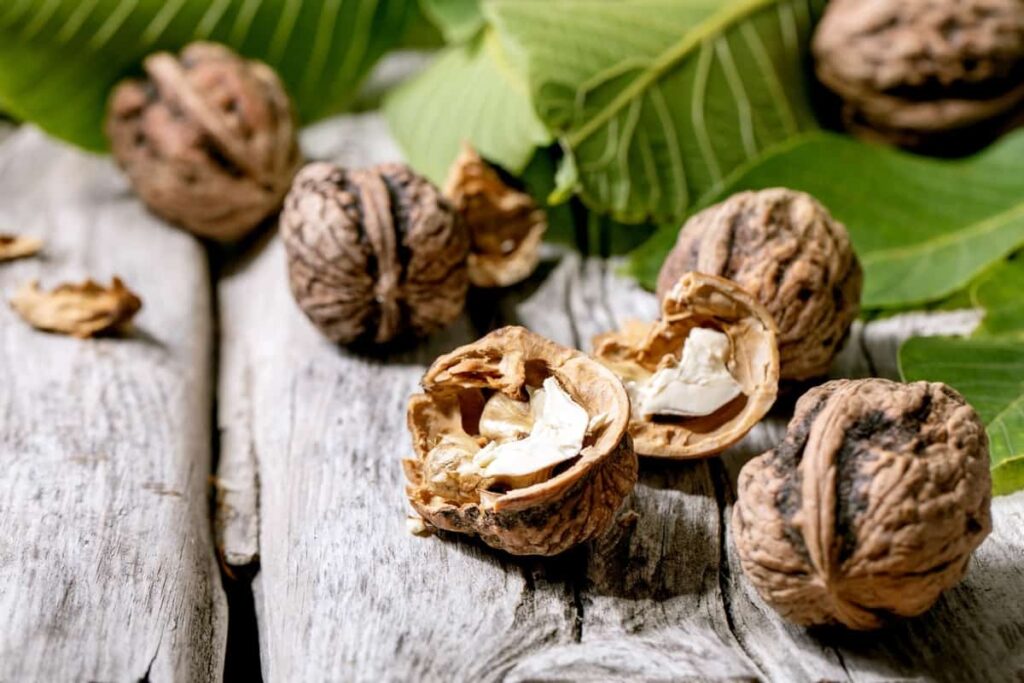
When training your Walnut tree’s shape, aim for a balanced form with evenly distributed branches around a central axis. Avoid overcrowding one side by regularly assessing branch spacing and making adjustments through selective pruning. Remember that proper timing is crucial when pruning Walnut trees. It’s generally recommended to prune during early spring while the tree is still dormant but before new growth begins.
Protecting Walnut Trees from Pests and Diseases
Common pests that affect Walnut trees include aphids, mites, scale insects, and codling moths. You can introduce beneficial insects to your garden to control these pests naturally. Additionally, regularly inspecting your trees for signs of infestation and promptly addressing any issues will help keep these pesky creatures at bay. Diseases such as crown gall, bacterial blight, leaf spot fungus, and powdery mildew are common concerns for Walnut tree growers.
Proper sanitation practices like removing fallen leaves or infected branches can prevent the spread of diseases. Applying fungicides or organic remedies may be necessary in severe cases. Regularly monitoring the health of your Walnut trees is crucial to identify any potential problems early on. By implementing these preventative measures against pests and diseases, you can ensure healthy growth for your beloved Walnut trees. Stay vigilant in protecting them so they bear abundant nuts year after year.
Understanding the Pollination Process in Walnut Trees
Walnuts are not self-pollinating, which means that they require cross-pollination from another tree to produce nuts. This method involves transferring pollen from the male flowers (catkins) of one tree to the female flowers (pistillate flowers) of another. To ensure proper pollination, it is important to have at least two varieties of Walnut trees planted nearby. The timing of bloom also plays a significant role in successful pollination.
It’s best if both trees are in full bloom simultaneously, as this increases the chances of pollen transfer between them. Bees and insects play an important role in pollinating Walnut trees by carrying pollen from one flower to another. Consider planting flowering plants nearby or providing bee houses to attract these beneficial insects.
Monitoring weather conditions during flowering is essential, as strong winds or heavy rains can disrupt pollen transfer. If necessary, hand-pollinate by collecting male catkins and gently brushing them against the pistillate flowers. By actively participating in the pollination process, you can increase your chances of a bountiful Walnut harvest year after year.
Attracting Pollinators to Ensure Successful Pollination
Firstly, choose flowering plants that are known to attract bees, butterflies, and other pollinators. Plant lavender, sunflowers, and wildflowers near your Walnut trees to provide an enticing food source. Another way to entice pollinators is by providing them with water sources. Fill shallow dishes or birdbaths with fresh water and place them near your trees. This will not only quench their thirst but also give them a reason to stick around.
In case you missed it: Idoo Hydroponics Growing System: How to Set Up, Use, and Troubleshoot
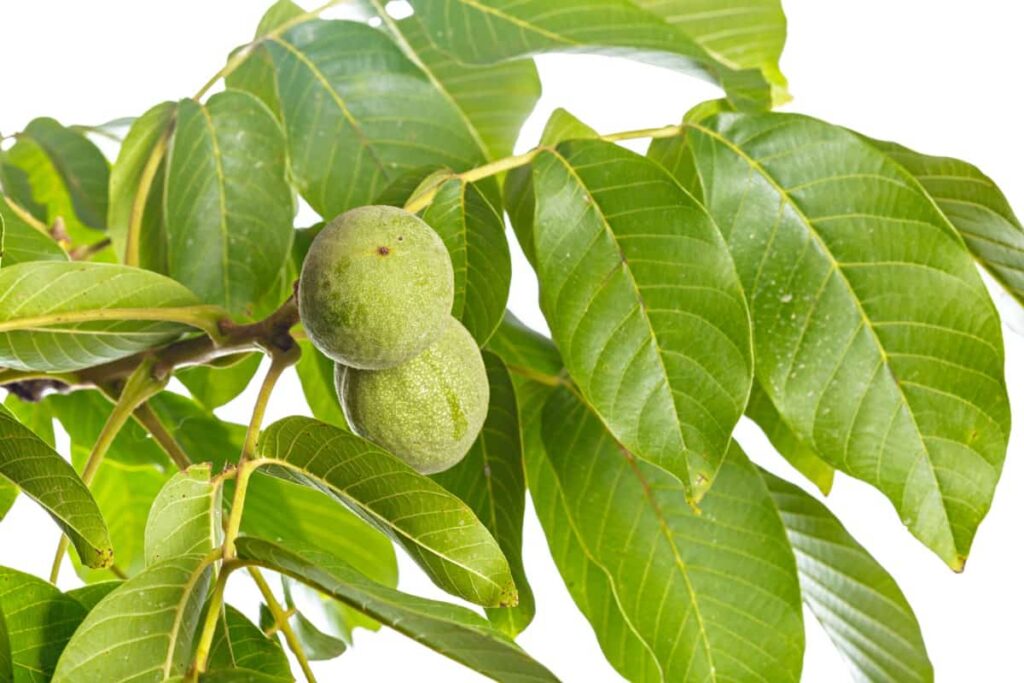
Additionally, avoid using pesticides on or around your Walnut trees as they can harm beneficial insects like bees and butterflies. Instead, choose natural pest control methods or organic alternatives. Consider creating nesting sites for native bees by leaving patches of bare ground or constructing bee houses in your garden. These small efforts can greatly attract more pollinators to your Walnut tree orchard.
Harvesting Walnuts: When and How to Collect the Nuts
Knowing when to collect the nuts can greatly affect their quality and flavor. The first tip is the color of the husks. As the nuts mature, the green husk starts turning yellow or brown. This indicates that they are nearing readiness for picking. Another way to check is by gently shaking a few branches; if some ripe nuts fall easily from their shells, it’s time to start gathering.
To collect your Walnuts, lay out a tarp or sheet under the tree and shake each branch carefully. The fallen nuts will accumulate on the ground below. Avoid leaving them too long on damp soil, affecting their quality. Once you’ve gathered all your precious Walnut bounty off the ground, removing any remaining husks before storing them for future use is important.
You can use gloves or stepping on them while wearing protective clothing. Remember that fresh Walnuts have high moisture content and need proper drying before storage – around 2-4 weeks, depending on weather conditions. Spread them in a single layer in a cool, well-ventilated area until they feel firm and crisp when cracked open.
Storing and Processing Walnuts for Long-Term Use
After harvesting Walnuts, it’s important to store them to maintain their freshness and flavor properly. Please make sure the Walnuts are completely dry before storing them. Moisture can cause mold growth and spoilage, so removing excess moisture from the nuts is crucial. Lay them out in a single layer on a clean tray or mesh screen, allowing them to air dry for about two weeks. Once dry, store the Walnuts in an airtight container. Make sure to label each container with the date of storage to keep track of their freshness.
How to Grow Walnut Tree at Home from Seed?
To start growing your Walnut tree, select high-quality Walnuts with intact shells. Soak the nuts in water for 24 hours to help soften the shell and increase germination rates. After soaking, carefully crack open the shell using light pressure without damaging the inner kernel. Once you have extracted the kernel, plant it in well-draining soil about 2 inches deep. Ensure you keep the soil consistently moist but not waterlogged during germination.
As your Walnut tree grows, provide ample sunlight and regular watering. Walnut trees thrive in full sun conditions and require deep watering once or twice weekly. Look for signs of pests or diseases, such as aphids or leaf spot. If necessary, treat these issues promptly to prevent them from affecting your tree’s growth. It’s important to note that growing a Walnut tree from seed requires patience, as it may take several years before it begins producing nuts.
How Much Time It Take to Grow a Walnut Tree from Seed
On average, Walnuts grown from seed take 10-13 years to start producing nuts. This time can change depending on several factors, such as the Walnut tree variety, climate conditions, soil quality, and proper care.
How to Plant a Walnut Tree in a Container?
Planting a Walnut tree in a container can be a good option for those with limited space or who want more control over the tree’s growth. With proper tree care, you can enjoy the beauty of this majestic tree right on your patio or balcony. Select a large pot or container with good drainage holes to grow a Walnut tree in a container. Make sure it is deep enough to accommodate the long taproot of the young seedling.
Selecting the right Walnut variety is crucial when growing in containers. Dwarf varieties such as ‘Gala’ or ‘Wepster’ are ideal as they reach smaller sizes than standard trees without compromising fruit quality. Place your potted Walnut tree in an area that receives at least 6 to 8 hours of direct sunlight daily.
In case you missed it: 17 Honeyberry Varieties: Best Cultivars to Grow in your Garden
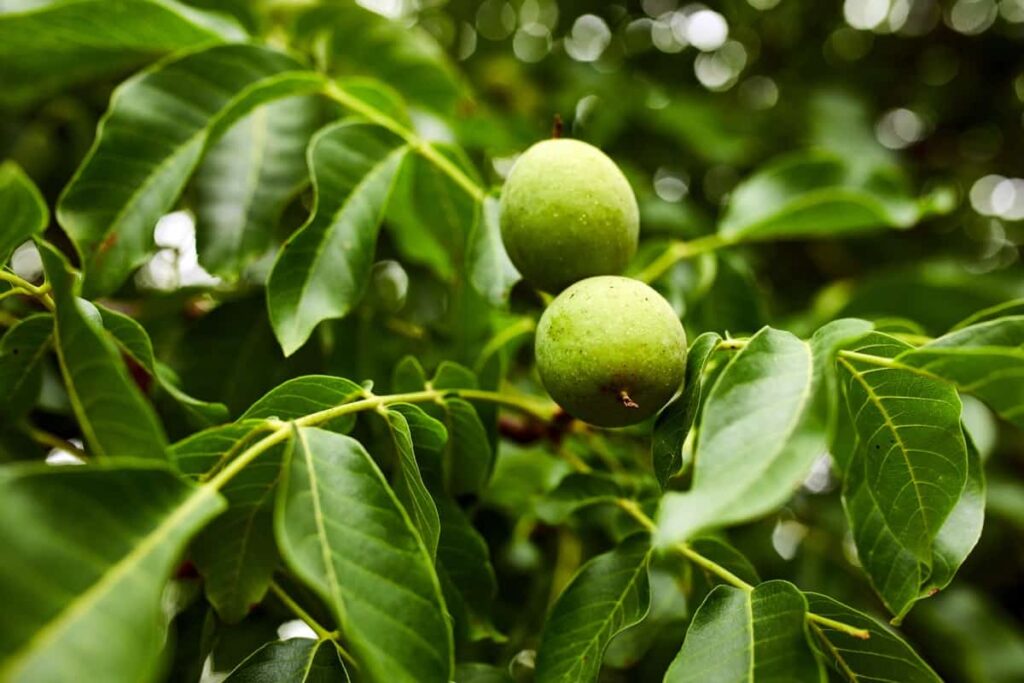
During the growing season, provide regular fertilizer applications every four to six weeks to ensure optimal nutrient uptake. Regular pruning should be done to maintain shape and promote airflow within the canopy. Remember that container-grown Walnut trees may require additional winter protection since their roots are exposed above ground level. Insulate pots by wrapping them with burlap or moving them indoors during freezing temperatures.
When Do Walnut Trees Produce Nuts?
When it comes time for harvesting, be patient; it may take several years before your Walnut tree starts producing nuts. On average, Walnut trees start bearing fruit around 8-10 years of age, but there have been cases where they begin as early as 5-7 years old. Once harvested, store your Walnuts properly to preserve their freshness for long-term use, or consider processing them into various culinary delights like roasted snacks or homemade desserts.
Conclusion
Walnut trees are stunning additions to any landscape and provide delicious and nutritious nuts that can be enjoyed straight from the tree or used in various culinary delights. Walnut trees are beautiful additions to any landscape and provide an abundance of tasty nuts that can be used fresh or in various recipes. Growing Walnut trees at home gives you total control over the quality and cultivation practices.
- Management Pests and Diseases in Your Cotton Field
- Sheep Farming Business Plan for Beginners
- Aquaponic Farming at Home: A Step-By-Step Guide
- Profitable Village Farming Business Ideas in 2024
- High-Yield Aquaculture: Fast-Growing Fish for Farming
- Effective Fish Pond Construction Techniques for Beginners
- Irrigation and Water Management in Pineapple Farming
- Blossom to Harvest: Mastering Flowering and Pollination in Papaya Farming
- Pig Fattening Essentials: From Selection to Sale for Beginners
- Raising Wagyu Cattle: A Complete Guide for Premium Beef Production
- Soil Types and Their Water Holding Capacity
- Optimizing Irrigation Schedules for Coconut Groves for Enhanced Yield
- Espresso Your Garden: Coffee Grounds for Healthier Acid-Loving Plants
- The Best Soil Mix for Snake Plants: How to Mix Your Own Snake Plant Soil
- Green Thumb Success: Expert Tips for Cultivating Greenhouse Beans All Year Round
- Bloom All Year Round: The Ultimate Guide to Indoor Hyacinth Care
- Eco-Friendly Gardening: How to Make Liquid Fertilizer from Kitchen Waste
- Ultimate Guide to Grow Anise in Pots: Explore Seed Propagation to Harvesting
- Guide to Raising Chester White Pigs: Discover Breed Facts to Growth Management
- Mastering the Elegance: The Ultimate Guide to Weeping Cherry Tree Care, Planting, and Maintenance
- Ultimate Guide to Planting Garlic in Grow Bags: Growing Strategies for Beginners
- How to Fix Spider Plant Leaf-Related Problems: Natural and Organic Remedies
- 10 Reasons Why Your Tulsi Plant is Shedding Leaves: Home Remedies and Solutions
- Optimizing Growth and Yield: The Advantages of Palm Bunch Ash Fertilizer
- Utilizing Neem Oil Extract as a Natural Pesticide for Hydrangea
- From Soil to Harvest: Various Ways in Which Farmers Can Use AI Tools
- Steps to Encourage and Induce Citrus Flowers: A Comprehensive Guide
- How to Fix Snake Plant Leaf-Related Issues: Natural and Organic Remedies
- Transform Your Garden into a Fragrant Oasis with Raat Ki Rani (Night Blooming Jasmine)
- Discover the Ideal Chicken Breeds for Philippine Farms
- How to Create a Poultry Egg Farm Business Plan for Profits
- Grow Lemon Cucumbers Like a Pro: Insider Techniques for Bountiful Yields
- Ultimate Guide to Caring for Your Pink Princess Philodendron: Tips for Thriving Variegation
- Areca Nut Profit Per Acre: Calculating Yield and Cost of Cultivation
- How Kaveri Chicken is Becoming a More Profitable Breed in Indian Backyards
- Transform Your Barn: 9 Steps to Convert a Horse Stall into a Chicken Coop
